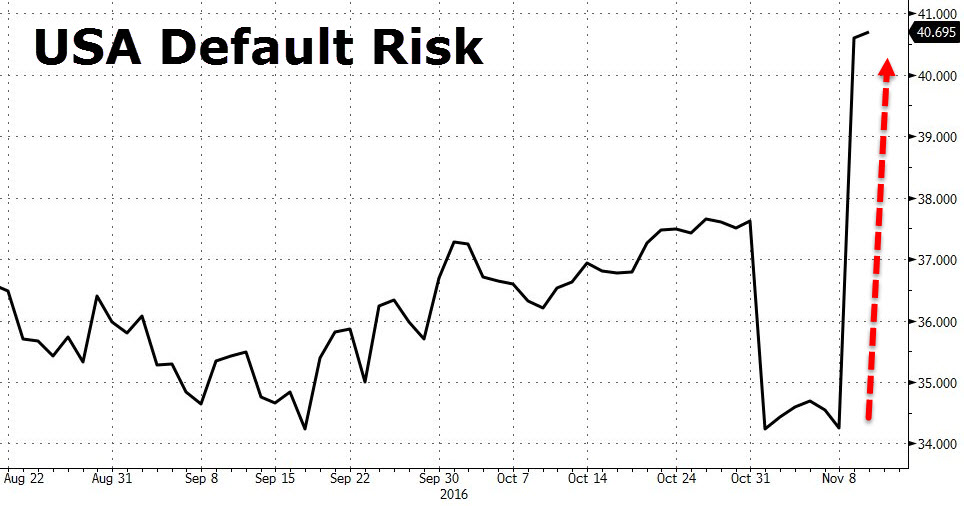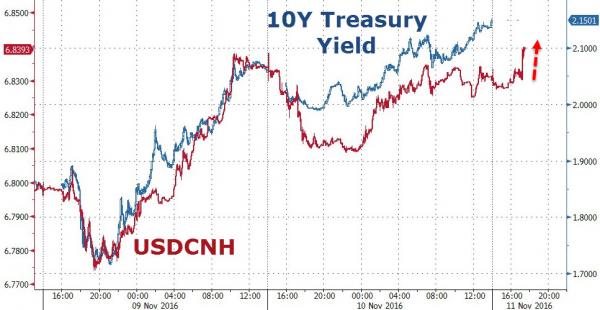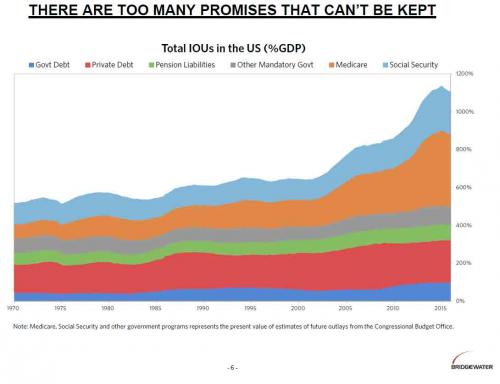The US election results are in and the US stock market is enjoying a sharp rally over the shock news of Donald Trump winning the election and becoming the new President-elect.
On the back of the big rally in US stocks there has also been another big shift occurring in another very important asset class, US Government bonds.
US Government Bond Yields Surging
Since the news of the results of the US election was released, US Government bonds have experienced a huge sell-off in prices causing the yields to surge on Government bonds ranging from the 2-year all the way to the long end, with the 30-year Treasury. (Note: Bond yields move inversely to bond prices.)
Specifically the US 10-year bond has seen the yield jump from around 1.80% before the election results to the current price of around 2.13%. (See chart below)
In the chart below you can see the magnitude of the rise in US 10-year yield reaching the same level as the S&P 500 dividend yield.
Traditionally bond yields help to price the relative value of stocks. If bond yields rise, the dividend yield on stocks would also have to rise. Usually dividend yields are above bond yields to entice investors into owning riskier stocks over more conservative bonds. For the yield to rise on stocks, either dividends would need to go up, or stocks would have to fall in price to lift the dividend yields.
So the fact that the 10-year bond yield has reached the same level as the S&P 500 dividend yield means that a bond investor can receive the same yield as he would from stocks without the perceived risk.

Normally when Government bond yields go up considerably, it's an indication that either inflation is also rising and / or the economy's growth prospects are accelerating. When the economy start to accelerate its growth prospects investors traditionally buy stocks in anticipation of higher profits and dividends from a stronger economy and sell bonds which are considered defensive assets.
Many analysts and financial commenters have already come out and suggested that growth is now back on the agenda for the US economy since the electing of Trump as the new president. Because of the Trump factor these commentators have suggested this is the reason why bond yields are rising and suggest it's a positive.
Why Surging Bond Yields Signals Pain Ahead
However we are not in normal times and there is a very big reason why the Fed has spend the majority its balance sheet trying to keep US Government bond yields low, by buying them through the various QE programs and artificially forcing the bond prices higher lowering the yield.
It's also the same reason why the Fed has only increased the interest rates once back in December 2015 and has been terrified to rise them further since then. The reason is because the US has a major debt problem from a Government , corporate America and consumer level.
So if the Fed has tried all this time to keep rates lows, how is it all of a sudden a good thing for the Government, corporate America, the consumer and the economy that interest rates are now rising. Especially when the debt levels in the US are higher now than before the 2008 GFC event that shook the US and Global economy.
Increased Government Spending
Back in August this year Trump gave a short interview with CNBC, discussing some of the problems in the US and how he was going to fix them.
In the video below he specifically discusses increasing spending on the military as well contributing over $500 billion to the ailing infrastructure in the US.
How Will It Be Paid For?
When asked by the CNBC host how will he pay for all the new additional spending he planned for the US economy. Trump said that he was willing to increase Government debt to fund it as one of the possible strategies. He further added that since interest rates are so low it would be wise to take advantage of the current low rate environment and borrow.
Bond Yields Reacting To Trump Plan
Now Trump will be the new US president I believe Government bond yields are surging not because growth will skyrocket in the US, but because they know that US debt under Trump will rise even faster than under Obama.
If Trump does plan to massively increase Government debt to pay for military and infrastructure spending, he is going to find out quickly that interest rates will not stay low for long.
Bond yields will continue to rise simply because bond investors will reprice US Government debt and the subsequent yield they will demand, to reflect the anticipated surge in debt coming over the next few years. The repricing of US Government bonds will occur to reflect the higher perceived risk of a potential default from considerably higher debt levels.

China Reacts To Trump Presidency
The Chinese yuan / US dollar pair has been depreciating for while now, however the depreciation against the US dollar has accelerated recently. The currency pair is following closely with the US 10yr Govt bond yield since news of Trump's win was released to the world. (See chart below).
Since China is a large trading partner with the US and China holds a large portion of US Government bonds this is important, as the devaluation of the yuan and its correlation to the 10 yr yield could indicate that China has accelerated its dumping of US Government bonds in reaction to Trump become President and the potential shift in Trump's trade policies effecting China.

China A Seller Of US Government Bonds
The chart below shows that China has been slowly selling US bonds since August 2015 reducing its holding from over $3 trillion to just below $2.8 trillion with the latest data.
If China decides to dump their holdings of US bonds rather than a gradual selling as has been the case, you could see US bond yields surging significantly higher due to the large amount China currently holds.
Once again given the high debt levels in the US this would create a lot of pain for the US, as US Government bond yields are used to price consumer, corporate, auto and housing loans. If the bond yields continue to rise it will squeeze the cash flow of debtors in the US and the economy will quickly feel the impact as the economy will buckle with higher interest rates.

US Debt Obligations Impossible To Repay
A number that has been raised a few times recently during the lead up to the election results was the total US Government debt of around $20 trillion. However what vary rarely gets mentioned is all of the total obligations or promises that the US Government has made. These include the pension obligations, medicare, social security to name a few.
Ray Dalio from Bridgewater has put together a brilliant chart that encompasses all the Government IOU's as well private debt. (See chart below)
What you will notice is that on the right hand side of the chart that total US debt to GDP stands at over 1000% to GDP. This means that debt is over 10 times to the yearly GDP of the US economy and is too high for the economy to be able to effectively grow out of it. This explains why the US recovery has been so sluggish despite zero interest rates.
With such a high proportion of IOU's relative to the size of the US economy, you can clearly understand why higher bond yields will cause a lot of pain in the future for the US.

The previous chart above on the US IOU's is actually a global trend with many countries having a similar looking chart with Government and Private debt rising rapidly over the years.
When you take a look at the chart below on the left, you can understand why Central Banks around the world have struggled to lift rates over the last 5 years. The reason they have not been able to normalize is that debt levels globally are too high to sustain in any interest rate rise.
In fact over the last 18 months or so many Central Banks have cuts rates to further spur economic growth without much success.
Central Banks Stuck In Interest Rate Limbo
In previous economic cycles after Central Banks cut interest rates to stimulate the economy they were able to lift them higher as the economies expanded. However in 2016 the debt levels have grown so high relative to GDP just like the US, the global economy is no longer able to handle higher rates without crashing the Global economy.
As an example on the global debt problem, I recently wrote an article about the huge ballooning debt in China and how its negatively effect the economy. See: Chinas debt bubble threatens global growth.
The only solution to the debt problem for the Central Banks (CB's) is QE liquidity injections to keep the status quo going. The chart below on the right shows the global equities market addiction to CB's liquidity, with a strong correlation to movements in liquidity. What this shows is that stock markets follow CB's liquidity above the actual strength or weakness of economies.

We Have Reached Our Debt Limits
In September Ray Dalio outlined very simply that we have reached the Debt limits globally, and low rates and lower interest payments no longer work because the debt is too high to have any additional stimulus effect on growth. (See video below)
If you have not seen this short video before take a look to hear Ray explain the current problem the world is facing.
Higher Bond Yields To Cause Economic Pain
Therefore on the flip side if the debt is too high that low rates no longer cause an stimulus boost or economic impact, higher rates will negatively impact the US economy. This is because as higher rates ultimately reduce demand as higher interest payments take a higher share of disposable income and reduce overall spending power.
If overall spending demand is reduced in the economy this will lead into another recession or deeper economic crisis.
Considering the US economy is already weakening as recent economic indicators is signalling a slowing economy or even recession see: US economy continues to weaken.
Higher bond yields will therefore only tip the US economy faster into economic contraction.
